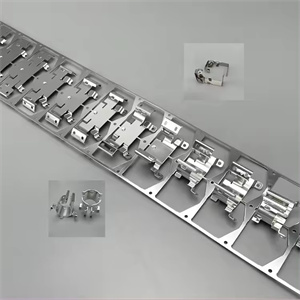Progressive die stamping, also known as progressive mold, is a type of mold composed of multiple workstations. Each workstation is sequentially associated to complete different processing tasks, and in one stroke of the punching machine, it can complete a series of different stamping processes. This mold structure allows the punch feeder to move the material forward according to a fixed step distance after a single stroke is completed, thereby completing multiple processes on a single mold, which may include punching, dropping, bending, trimming, deep drawing, and so on.
Progressive die stamping molds are widely used in multiple industries, especially in the automotive and hardware products industries. In the automotive industry, progressive die stamping molds are used to manufacture exterior components such as doors, locks, steering gear, seats, as well as important components such as engines, chassis, and body, ensuring quality and efficiency. In the hardware products industry, the application of progressive die stamping molds covers kitchen and bathroom hardware, bathroom hardware, and workshop supplies, suitable for manufacturing with complex structures and high-precision requirements.
In addition, progressive molds have their unique applications in mold design and development. The use of progressive die stamping molds can divide the entire process into multiple stages to improve controllability and quality. From the perspective of mold manufacturing, the design of progressive die stamping molds also takes into account engineering changes during the manufacturing process and the convenience of mold maintenance in subsequent stamping production. For example, the lower (concave) die, small bending convex die, and unloading part often adopt a block structure.
Progressive die stamping die is an efficient type of stamping die. Its main characteristics include:
Multi station continuous processing: Setting up multiple stations in a mold, through the continuous movement of the mold, the material completes various processes such as punching, bending, and stretching in different stations, achieving one-time processing of complex parts.
Efficient production: It can greatly improve production efficiency, reduce production cycles, and is suitable for large-scale production.
High precision: By precise mold design and manufacturing, the machining accuracy of each workstation is ensured, thereby obtaining high-precision stamped parts.
High material utilization rate: Reasonable layout design can minimize waste and improve material utilization rate to the greatest extent.
The structure of Progressive die stamping molds is relatively complex, usually including the following parts:
Upper and lower mold seats: provide the installation foundation and support for the mold.
Guide pillar and guide sleeve: Ensure precise guidance of the upper and lower molds, ensuring stamping accuracy.
Station punch and die: Each station has a corresponding punch and die, used to complete specific processes.
Unloading device: including unloading plate, top bar, etc., used to unload stamped parts or waste from the mold.
In the manufacturing of automotive components, Progressive die stamping molds can quickly produce a large number of precision parts, such as body structural parts; In the electronics industry, it can be used to manufacture complex small parts such as connectors.
